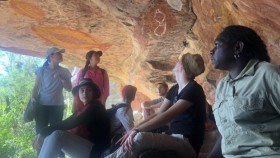Science over summer
As campus takes a break, we have a look at some of the science which never stops – and the people who keep it running, every day of the year.
People in glasshouses
Plants being grown for research and teaching at the ANU Research School of Biology are maintained by the Plant Services Team. They support 50 greenhouses, plus 20 walk-in growth rooms and 34 free-standing growth chambers located in the Controlled Environment Facility.
Watering happens twice a day, every day of the year, and can take a total of five hours to complete in the summer. Detailed watering instructions ensure requirements are met for different experimental settings.
“We can’t use automatic irrigation because we’re not growing a single crop in all greenhouses,” explains Christine Larsen, the Plant Services Coordinator. “We’re growing everything from tall tobacco plants to small alpine bluebells, and plants with such varying water requirements as flood-irrigated rice and succulents.
“It’s in our interests to keep things well watered, well fertilised, and potted up. As soon as the plants are stressed, you notice the pests and diseases coming in – and pests and diseases don’t take a holiday, unfortunately!”
Baby fish doo-doo doo-doo
The temperature-controlled aquaria at the ANU Research School of Biology house guppies and mosquito fish being studied by behavioural ecologists and evolutionary biologists. The fish are fed, and water levels checked, in the mornings and afternoons, every day of the year.
Mahmud Al Hasan and Fatema Akhter are PhD researchers studying how the fish behave in and adapt to changing environments, including as a result of climate change.
“I will usually come to see if there are any babies, and if there are, I take the babies out and put them in a new tank with water from the stock tank and weeds and stones,” Mahmud says of his routine tasks. “They are all labelled ‘baby’ and yes, I feel like they are my babies!”
Skinky business
Scientists at the ANU Research School of Biology are studying common garden skinks and delicate skinks to see how their metabolism and behaviour is affected by changes to their early environment, including climate change-induced temperature increases.
The lizards are cared for by technician Michelle Stephens who feeds them three times a week and maintains their living environment.
PhD researchers Pablo Recio Santiago (pictured) and Dalton Leibold check on the lizards to see if there are new eggs or new babies, with support from summer intern Amelia Peardon (also pictured).
“We look for eggs and if we find any, we put them in cups and into the incubators set at two different temperatures,” Pablo explains. “It seems simple but believe me, we have been working for three months and it is a lot of work! I am very excited to see the results.”
Canberra’s coral reef
The coral reef tank is housed at the ANU Research School of Earth Sciences and is used as a stock tank for scientists studying impacts of changing seawater chemistry on coral growth. Maintenance includes topping up the tank with seawater, removing algae, checking the salinity and temperature of the water, and monitoring all chemical parameters to keep the coral healthy.
Sam Eggins, a PhD researcher studying marine biogeochemistry, says the biggest challenge in looking after the coral reef tank is keeping down the algal growth.
“In theory the fish help to keep down the algae,” Sam says. “But we still need to scrub it. We don’t have to feed the fish, but we do have to feed the coral!”





























